1994 PONTIAC GRAND-AM oil change
[x] Cancel search: oil changePage 183 of 274
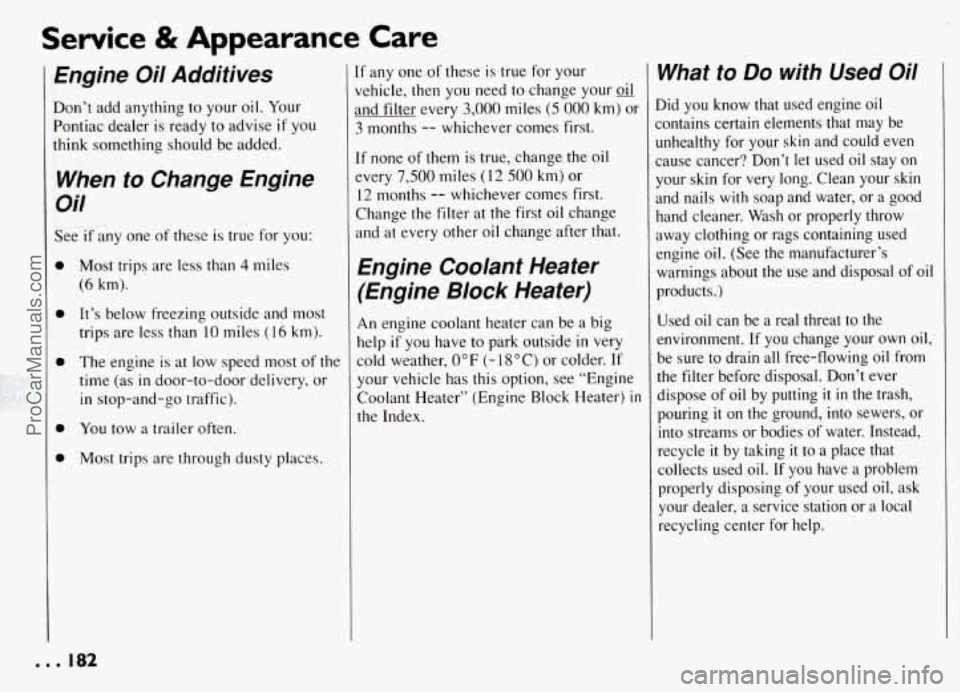
Service & Appearance Care
Engine Oil Additives
Don’t add anything to your oil. Your
Pontiac dealer is ready to advise
if you
think something should be added.
When to Change Engine
Oil
See if any one of these is true for you:
Most trips are less than 4 miles
(6 km).
It’s below freezing outside and most
trips are less than
10 miles ( 16 km).
The engine is at low speed most of the
time (as
in door-to-door delivery, or
in stop-and-go traffic).
You tow a trailer often.
Most trips are through dusty places.
[f any one of these is true for your
Vrehicle, then you need to change your oil
md filter every 3,000 miles (5 000 km) or-
3 months -- whichever comes first.
[f none of them is true, change the oil
=very 7,500 miles (12 500 km,) or
12 months -- whichever comes first.
Change the filter at the first oil change
and at every other
oil change after that.
Engine Coolant Heater
(Engine Block Heater)
An engine coolant heater can be a big
help if
you have to park outside in very
cold weather,
0°F (- 18OC) or colder. If
your vehicle has this option, see “Engine
Coolant Heater” (Engine Block Heater)
in
the Index.
What to Do with Used Oil
lid you know that used engine oil
:ontains certain elements that may be
Inhealthy
for your skin and could even
:awe cancer? Don’t let used oil stay on
your skin for very long. Clean your skin
md nails with soap and water, or a good
land cleaner. Wash or properly throw
lway clothing or rags containing used
mgine oil. (See the manufacturer’s
warnings about the use and disposal of oil
products.)
Used oil can be a real threat to the
mvironment.
If you change your own oil,
be sure to drain all free-flowing oil from
the filter before disposal. Don’t ever
dispose of oil by putting
it in the trash,
pouring
it on the ground, into sewers, or
into streams or bodies of water. Instead,
recycle
it by taking it to a place that
collects used
oil. If you have a problem
properly disposing of your used oil, ask
your dealer, a service station or
a local
recycling center for help.
... 182
ProCarManuals.com
Page 185 of 274
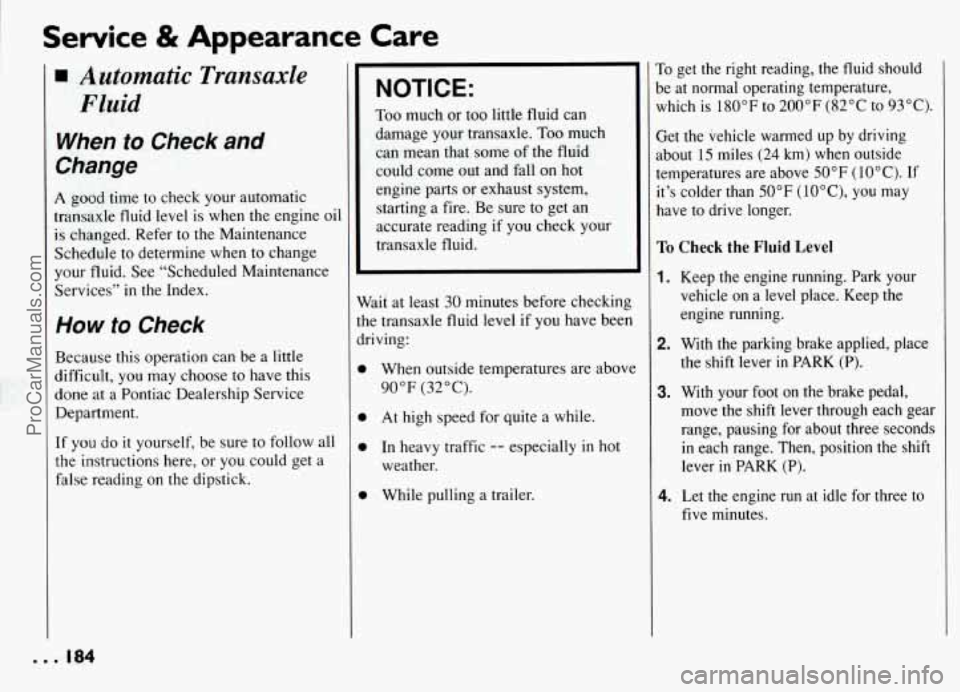
Service & Appearance Care
Automatic Transaxle Fluid
When to Check and
Change
A good time to check your automatic
transaxle fluid level is when the engine oil
is changed. Refer to the Maintenance
Schedule to determine when to change
your fluid. See “Scheduled Maintenance
Services” in the Index.
How to Check
Because this operation can be a little
difficult, you may choose
to have this
done at a Pontiac Dealership Service
Department.
If you do it yourself, be sure to follow all
the instructions here, or you could get a
false reading on the dipstick.
NOTICE:
Too much or too little fluid can
damage your transaxle.
Too much
can mean that some of the fluid
could come out and fall on hot
engine parts or exhaust system,
starting a fire. Be sure
to get an
accurate reading if you check your
transaxle fluid.
Wait at least 30 minutes before checking
the transaxle fluid level
if you have been
driving:
0 When outside temperatures are above
90°F (32°C).
0 At high speed for quite a while.
0 In heavy traffic -- especially in hot
weather.
0 While pulling a trailer.
To get the right reading, the fluid should
,e at normal operating temperature,
which is 180°F to 200°F (82°C to 93°C).
Set the vehicle warmed up by driving
ibout 15 miles
(24 km) when outside
iemperatures are above
50°F (10°C). If
it’s colder than 50°F
(IOOC), you may
have to drive longer.
To Check the Fluid Level
1. Keep the engine running. Park your
vehicle on a level place. Keep the
engine running.
2. With the parking brake applied, place
the shift lever in PARK (P).
3. With your foot on the brake pedal,
move the shift lever through each gear
range, pausing for about three seconds
in each range. Then, position the shift
lever in PARK
(P).
4. Let the engine run at idle for three to
five minutes.
ProCarManuals.com
Page 187 of 274

I Service & Appearance Care
Manual Transaxle
Fluid
When to Check
A good time to have it checked is when
the engine
oil is changed. However, the
tluid
in your manual transaxle doesn't
require changing.
How to Check
Because this operation can be a little
diftlcult,
you may choose to have this done
at a Pontiac Dealership Service Department.
If you do it yourself, be sure to follow a11
the instructions here, or you could get a
false reading on the dipstick.
NOTICE:
Too much or too little tluid can
darnage
your transaxle. Too much
can mean that some
of the tluid
could come out and fall
011 hot
engine parts or exhaust system,
starting a fire. Be sure
to get an
accurate reading
if you check your
transaxle fluid.
Check the tluid level only when your
engine IS off. the vehicle is parked on a
level place and the transaxle is
cool
enough for you to rest your fingers on the
transaxle case.
I
hen, Follow These Steps:
I Flip the handle up and the.n pull out
the dipstick and clean it with a rag or
paper towel.
2. Push it back in all the way and remove
It.
3. Check both sides of the dipstick and
read the lower level. The fluid level
must be between the
ADD and FULL
marks. (Note: Fluid may appear at the
bottom
of the dipstick even when the
tluid level is several pints low.)
4. If the tluid level is where it should be,
push the dipstick back in all the way
and flip the handle down. If the fluid
level is low. add more fluid as
described
in the next steps.
. .* 186
ProCarManuals.com
Page 206 of 274
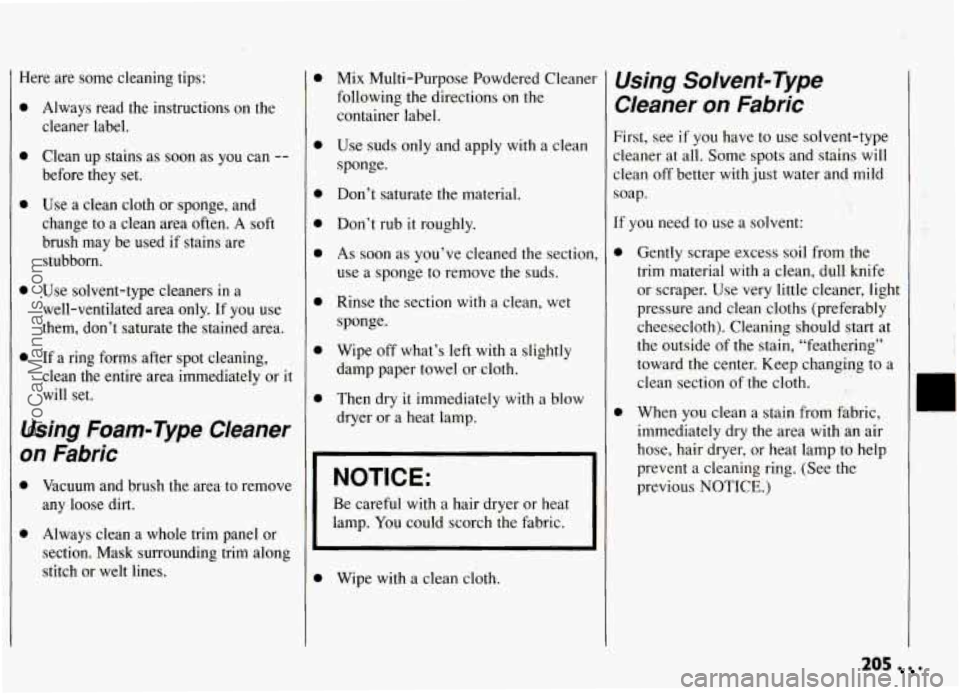
Here are some cleaning tips:
0
0
0
0
0
Always read the instructions on the
cleaner label.
Clean up stains as soon as you can
--
before they set.
Use a clean cloth or sponge, and
change to a clean area often. A soft
brush may be used if stains are
stubborn.
Use solvent-type cleaners in a
well-ventilated area only. If you use
them, don’t saturate the stained area.
If a ring forms after spot cleaning,
clean the entire area immediately or
it
will set.
Using Foam-Type Cleaner
on Fabric
0 Vacuum and brush the area to remove
any loose dirt.
0 Always clean a whole trim panel or
section. Mask surrounding trim along
stitch or welt lines.
0
0
0
0
0
0
0
0
Mix Multi-Purpose Powdered Cleaner
following .the directions on the
container label.
Use suds only and apply with a clean
sponge.
Don’t saturate the material.
Don’t rub
it roughly.
As soon as you’ve cleaned the section,
use a sponge to remove the suds.
Rinse
the section with a clean, wet
sponge.
Wipe off what’s left with a slightly
damp paper towel
or cloth.
Then dry it immediately with a blow
dryer or
a heat lamp.
NOTICE:
Be careful with a hair dryer or heat
lamp. You could scorch the fabric. ~
0 Wipe with a
clean cloth.
Using Solvent-Type
Cleaner on Fabric
First, see if you have to use solvent-type
cleaner at all. Some spots and stains will
clean off better
with just water and mild
soap.
If you need to use a solvent:
0
0
Gently scrape excess soil from the
trim material with a clean, dull knife
or scraper. Use very little cleaner, light
pressure and clean cloths (preferably
cheesecloth). Cleaning should start at
the outside
of the stain, “feathering”
toward the center. Keep changing to a
clean section of the cloth.
When you clean a stain from fabric,
immediately dry the area with an air
hose, hair dryer, or heat lamp to help
prevent a cleaning ring. (See the
previous NOTICE.)
205 .
ProCarManuals.com
Page 224 of 274

IMPORTANT:
KEEP ENGlNE OIL
AT THE PROPER
LEVEL AND CHANGE AS
RECOMMENDED
1 This part covers the maintenance
I required for your Pontiac . Your vehick
needs these services to retain its
1 safety. dependability and emission
control performance
.
.... - .,. ....... ..
Have you purchased the
GM Protection Plan?
The Plan supplements your new vehicle warranties
.
See your Pontiac dealer for details .
Part 7
Maintenance Schedule
Introduction
A Word About Maintenance ..................................... 224
Your Vehicle and the Environment
................................ 224
How This Part
is Organized ..................................... 224
Using Your Maintenance Schedules . . ...................... 225
Selecting the Right Schedule
.................................... 225
Schedule1
................................................... 226
Schedule11
.................................................. 228
Explanation
of Scheduled Maintenance Services ................... 230
At Each Fuel Fill ............................................. 232
At Least Once a Month ......................................... 233
At Least Once a Year
.......................................... 233
AtLeastTwiceaYear
.......................................... 233
C . Periodic Maintenance Inspections ................................ 236
D . Recommended Fluids & Lubricants ................... ~ ......... 238
E . Maintenance Record .............................
~ ...... 240
A . Scheduled Maintenance Services
B . Owner
Checks & Services
223
ProCarManuals.com
Page 229 of 274
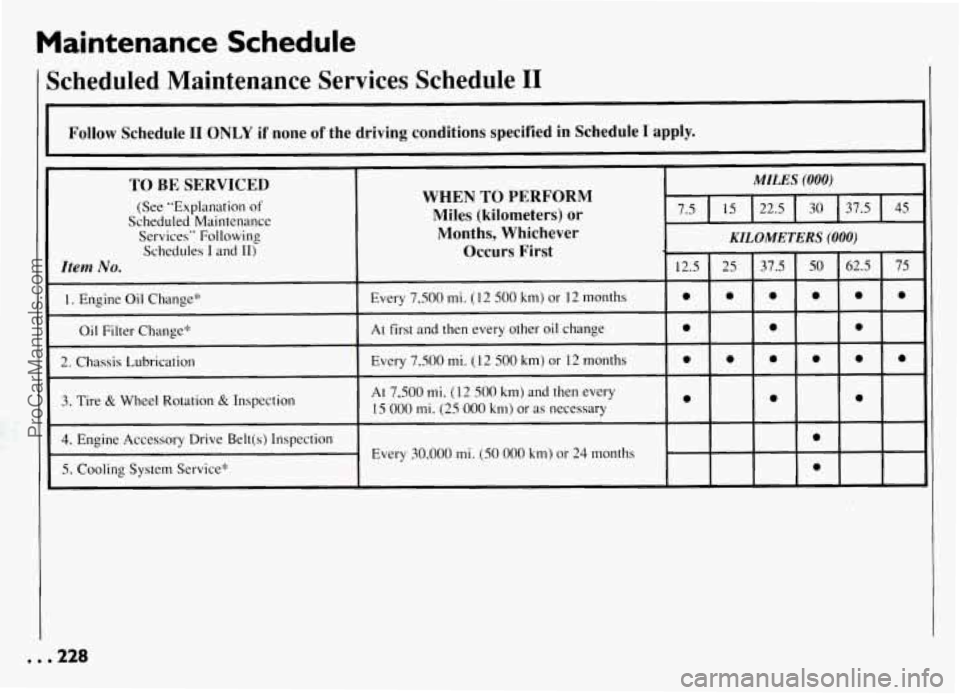
Maintenance Schedule
Scheduled Maintenance Services Schedule I1
Follow Schedule I1 ONLY if none of the driving conditions specified in Schedule I apply.
I
TO BE SERVICED
(See "Explanation of
Scheduled Maintenance Services" Following Miles (kilometers) or
Months, Whichever
KILOMETERS (000)
MILES (000)
WHEN TO PERFORM
Schedules I and 11,- Occurs First
Item No. 37.5 25
12.5
1. Engine Oil Change" Every
7,500 mi. ( 12 500 km) or 12 months
0,il Filter Change"
2. Chassis Lubrication At
first and then every other oil change
Every 7,500 mi. (12
500 km) or 12 months
0 0 0
0 0
0 0
0
3. Tire & Wheel Rotation & Inspection
4. Engine Accessory Drive Belt(s) Inspection
5. Cooling System Service*
At 7,500 mi. ( 12 500 km) and then every
15
000 mi. (25 000 km) or as necessary 0 0
Every 30.000 mi. (50 000 km) or 24 months
!
+
50 62.5
1
I
I.
t
. . .22a
ProCarManuals.com
Page 231 of 274
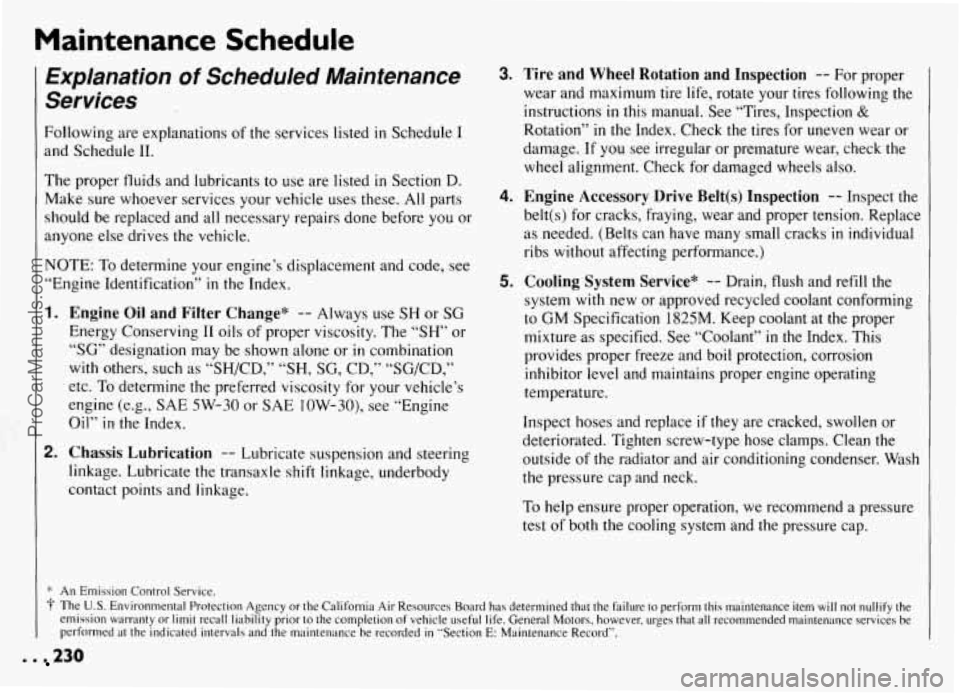
Maintenance Schedule
Explanation of Scheduled Maintenance
Services
Following are explanations of the services listed in Schedule I
and Schedule 11.
The proper fluids and lubricants to use are listed in Section D.
Make sure whoever services your vehicle uses these. All parts
should be replaced and all necessary repairs done before you or
anyone else drives the vehicle.
NOTE: To determine your engine’s displacement and code, see
“Engine Identification”
in the Index.
1.
2.
Engine Oil and Filter Change* -- Always use SH or SG
Energy Conserving I1 oils of proper viscosity. The “SH” or
“SG” designation may be shown alone or in combination
with others, such as “SH/CD,” “SH, SG, CD,” “SG/CD,”
etc. To determine the preferred viscosity for your vehicle’s
engine (e.g., SAE 5W-30 or SAE 10W-30), see “Engine
Oil”
in the Index.
Chassis Lubrication -- Lubricate suspension and steering
linkage. Lubricate the transaxle shift linkage, underbody
contact points and linkage.
3.
4.
5.
Tire and Wheel Rotation and Inspection -- For proper
wear and maximum tire life, rotate your tires following the
instructions
in this manual. See “Tires, Inspection &
Rotation” in the Index. Check the tires for uneven wear or
damage. If you see irregular or premature wear, check the
wheel alignment, Check for damaged wheels also.
Engine Accessory Drive Belt(s) Inspection -- Inspect the
belt(s) for cracks, fraying, wear and proper tension. Replace
as needed. (Belts can have many small cracks
in individual
ribs without affecting performance.)
Cooling System Service* -- Drain, flush and refill the
system with new or approved recycled coolant conforming
to
GM Specification 1825M. Keep coolant at the proper
mixture as specified. See “Coolant”
in the Index. This
provides proper freeze and boil protection, corrosion
inhibitor level and maintains proper engine operating
temperature.
Inspect hoses and replace if they are cracked, swollen or
deteriorated. Tighten screw-type hose clamps. Clean the
outside of the radiator and air conditioning condenser. Wash
the pressure cap and neck.
To help ensure proper operation, we recommend a pressure
test of both the cooling system and the pressure cap.
. . 230
ProCarManuals.com
Page 232 of 274

6. Transaxle Service -- For manual transaxles, fluid doesn’t
require changing. See “Periodic Maintenance Inspections.”
For automatic transaxles, change both the fluid and filter
every
15,000 miles (25 000 km) if the vehicle is mainly
driven under one or more of these conditions:
* In heavy city traffic where the outside temperature
regularly reaches 90°F (32°C) or higher.
0 In hilly or mountainous terrain.
0 When doing frequent trailer towing.
0 Uses such as found in taxi, police car or delivery
service.
If you -do not use your vehicle under any of these
conditions, change both the fluid and filter every
100,000 miles ( 166 000 km).
7. Spark Plug Replacement* -- Replace spark plugs with
the proper type. See “Replacement Parts” in the Index.
8. Spark Plug Wire Inspection (3.1L Code M engine
only)*?
-- Inspect for burns, cracks or other damage.
Check
the boot fit at the coils and at the spark plugs.
Replace wires as needed.
9. Air Cleaner Filter Replacement* -- Replace every
30,000 miles (50 000 km) or more often under dusty
conditions.
Ask your dealer for the proper replacement
intervals for your driving conditions.
1 O.Fuel Tank, Cap and Lines Inspection”? -- Inspect fuel
tank, cap and
lines (including fuel rails and injection
assembly) for damage or leaks. Inspect
fuel cap gasket for
an even filler neck imprint or any damage. Replace parts as
needed. Periodic replacement of the fuel filter is
not
required.
* An Emission Control Service.
3- The U.S. Environmental Protection Agency or the California Air Resources Board has determined that the failure to perform this maintenance item will not nullify the
emission warranty or limit recall liability prior to the completion of vehicle useful life. General Motors, however, urges that all recommended maintenance services be performed at the indicated intervals and the maintenance be recorded in “Section E: Maintenance Record”.
ProCarManuals.com